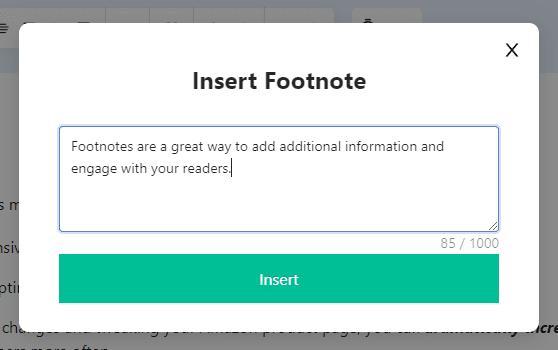
Footnotes are a key component of certain genres of books, particularly nonfiction. And yet, very few people use them properly.
This is largely due to the fact that it is hard to add footnotes to a book, especially for most formatting programs.
In the past you had to have a huge, expensive program like Adobe InDesign to add footnotes to your book, but now there is a tool that will do it for you with no hassle. More on that in a moment.
For now, let's discuss proper usage of footnotes in your book.
So I've been writing and formatting books for a long time. 10+ years as of this writing.
But I actually found formatting to be a huge pain, which is why I actually created my own formatting software that solved all my problems. I called it Atticus.
But this isn't meant to be a sales pitch. I just want to make sure it's clear that I know what I'm talking about. The amount of research that went into not only formatting my own books, but also creating a formatting software is huge.
I researched everything, from tiny margin requirements, to the specific type of quotes to use (curly or straight, it makes a difference).
And yes, of course, that includes footnotes.
So if all that makes sense, hopefully you'll come along with me as show you everything I've learned.
Footnotes are relevant notes placed at the bottom of your page, and are referenced from within the page (usually with superscript numbers).
The primary purpose of a footnote is to add additional information, without interrupting the flow of the writing.
That additional information can include:
Footnotes are fantastic tools to share information without overpowering the reader. However, there are certain guides and styles to use footnotes properly, and I will get into many of them in a moment.
Bonus: Formatting can be a difficult thing, especially when you have a vanilla tool like Microsoft Word. To make this process easier, I developed a tool to give you the template you need to format your book in Word. Get all the templates here! Check Out the FREE Formatting Templates
There is often some confusion about whether footnotes are the same as endnotes or vice versa. But footnotes are not the same as endnotes, though they do serve a similar purpose.
Otherwise, footnotes and endnotes are almost identical. They both are referenced with a small superscript number, and both refer to citations, additional information, etc. The only difference is the positioning of the note.
See this article for a full breakdown on the difference between footnotes and endnotes.
Footnotes will look different depending on what style you use, and so you want to make sure that they look like they should, and that you are using a consistent style throughout your book or essay.
Let's start by examining what the in-text citations look like.
To cite your footnote within the body of your text, start by including a small superscript number after the word or sentence where you want to place the reference.
If it is your first reference on the page, start with the number 1, if it is your second reference, go to number 2, and so on.
This will clue the reader in so they know which number to look for at the bottom of the page.
Here is an example of an in-text citation:
Alice was beginning to get very tired of sitting by her sister on the bank 1 , and of having nothing to do: once or twice she had peeped into the book her sister was reading, but it had no pictures or conversations in it. 2
The Chicago style is typically used for citations, though it can be used for other forms of footnotes as well.
For Chicago footnotes, you want to:
You may also want to have a complete list of sources in the back of your book in addition to these footnotes.
Here is an example of a Chicago-style footnote:
1. King, Stephen. On Writing: A Memoir of the Craft. New York, NY: Scribner, 2000.
2. King, Stephen. On Writing
APA-style footnotes are typically used for additional information instead of citations, though this is not a hard and fast rule. You can also use them for copyright clarification.
To use APA-style footnotes, remember the following:
Here is an example of APA footnotes:
1 King, S. (2000). On writing: A memoir of the craft. Scribner.
2 This is where you might make an additional note or comment related to the piece you are writing.
MLA footnotes can be used in a variety of ways, including additional information, citations, expansions, etc.
To do MLA-style footnotes well, remember the following:
Here's an example of an MLA-style footnote:
1 King, Stephen. On Writing: A Memoir of the Craft. Scribner, 2000.
2 This is where you might make an additional note or comment related to the piece you are writing.
If you're quoting a source directly in your material, you will want to add a footnote to cite your source so that you don't plagiarize.
To do this, use the exact words of the quote, place quotation marks around it, then placed your superscript number at the end of the quote, outside of the quotation marks.
To do this well, you are definitely going to need a good formatting program, the more automation the better.
Programs like Microsoft Word and Adobe InDesign have long had the features necessary to add footnotes, but it is a pain to do, and can take a lot of time to learn.
Other formatting software like Vellum don't even have this capability.
The best formatting program for adding footnotes is Atticus. It will not only add footnotes for you, automatically adding them to the bottom of each of your pages, but it allows you to do so with the click of a button.
You can check out Atticus here, or scroll down for more information.
While footnotes are primarily used in nonfiction books, there are some fun ways to use footnotes in fiction as well. Here are just a few ideas:
Adding footnotes in fiction can be a fun way to stand out from the crowd, and make the process fun to read.
It is crucial that you learn to cite your sources, especially if you are a nonfiction writer. If you used any information in your book from a source other than your own experience (which most of it will be), then you will want to cite those sources.
Thankfully, there is a tool to make this process a lot easier for you.
Atticus is the all-in-one program designed for authors to write and format their books with ease.
Not only will it automatically create your footnotes, but it does a lot of other things to. Here is a brief rundown of Atticus's features:
So if you want a program that makes footnotes easy, along with all of your other formatting needs, give Atticus a look.
Atticus is one of the only formatting programs that does easy-to-insert footnotes (Adobe InDesign does footnotes, but the software is incredibly difficult to learn).
Atticus makes the process easy. Start by choosing whether you want footnotes or endnotes in the Formatting Tab:

Then, simply find where you want to insert your footnote, and select the following button in the top tool bar:

This will create a pop-up where you can insert your desired footnote:

You will then see the footnote displayed in the main editor:

And that’s it! Once this is done, the footnotes will appear in your formatted documents. Here is what that looks like in the Print version:

Note also that for ebooks, your footnotes will be converted to endnotes, since footnotes only work in print.
It’s such an easy process that very few formatting tools have, and ONLY Atticus makes it this simple.
For a nice summary of this article, and a demonstration of how footnotes work in Atticus, be sure to check out this video.
Want more videos like this? Be sure to subscribe to my YouTube channel for weekly videos!
When I am not fighting dragons or chasing the bogey man out of my kids' closet, I like using my previous Online Optimization skills to help other authors with the 'technical' stuff and get the right authors to the top of Amazon and any other eBook service out there.
Posted in Book Formatting Tagged Formatting
Hi, I'm Dave Chesson
When I’m not sipping tea with princesses or lightsaber dueling with little Jedi, I’m a book marketing nut. Having consulted multiple publishing companies and NYT best-selling authors, I created Kindlepreneur to help authors sell more books. I’ve even been called “The Kindlepreneur” by Amazon publicly, and I’m here to help you with your author journey.